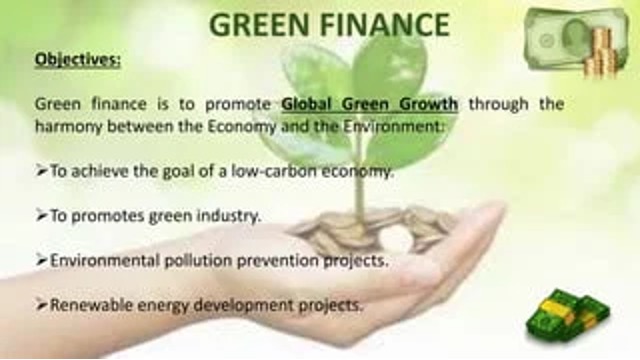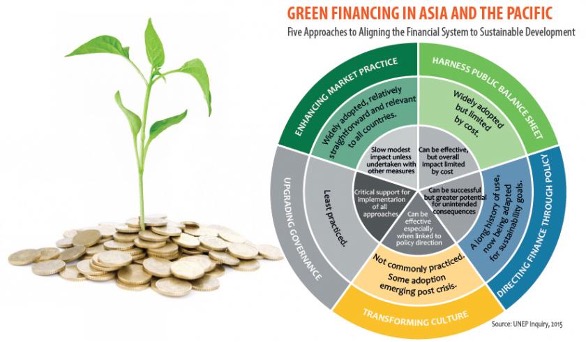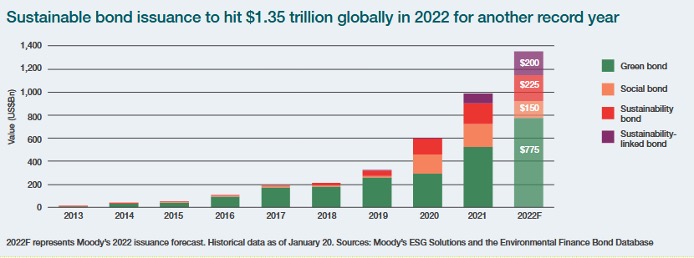What exactly is Green Finance?
Green finance refers to the deployment of financial resources to environmentally sustainable projects and initiatives. It encompasses a range of financial instruments, such as green bonds, loans, and insurance, which are directed towards projects with positive environmental impacts. The fundamental goal is to foster a harmonious coexistence between economic development and ecological preservation. This financial approach aligns economic activities with environmental responsibility, aiming to address pressing issues such as climate change, resource depletion, and pollution.
How did it all start?
The roots of green finance can be traced back to the increasing recognition of the environmental consequences of unchecked economic growth. The early 21st century witnessed a growing global awareness of climate change, prompting stakeholders to seek innovative solutions. The United Nations Environmental Programme (UNEP) played a pivotal role in initiating discussions on the integration of environmental considerations into financial decision-making processes. The term “green finance” gained prominence after the 2008 financial crisis, as policymakers and financial institutions sought to rebuild the economy with sustainability at its core.

What are the limitations?
While green finance represents a commendable step towards sustainability, it has challenges and limitations. One significant hurdle is the lack of universally accepted standards and definitions for what constitutes a “green” project. This ambiguity can lead to greenwashing, where projects with minimal environmental impact are portrayed as more sustainable than they truly are. Additionally, the measurement and verification of the environmental impact of financed projects remain complex, making it challenging to ensure the authenticity of green investments.
The scarcity of comprehensive data on the long-term environmental performance of green projects poses another limitation. Investors and financial institutions often face difficulties in accurately assessing the success and impact of their green investments over time. Furthermore, the initial costs associated with environmentally friendly technologies and practices can be higher, deterring some investors from engaging in green finance.
How has it benefited Entrepreneurship?
Green finance has the potential to catalyze entrepreneurial innovation and economic development by creating a conducive environment for sustainable businesses. Entrepreneurs involved in renewable energy, clean technology, and eco-friendly initiatives can access capital more easily through green finance channels. This not only accelerates the transition to a low-carbon economy but also encourages the development of innovative solutions to pressing environmental challenges.
Moreover, green finance can enhance the reputation of businesses committed to sustainability. Consumers and investors are increasingly valuing companies that prioritize environmental responsibility, leading to increased market share and brand loyalty. This positive feedback loop encourages entrepreneurs to integrate green practices into their business models, fostering a more sustainable and responsible corporate culture.
Providers of Green Loans
The landscape of green finance is populated by a diverse array of financial institutions, ranging from traditional banks to specialized green investment funds. Traditional banks have started incorporating green finance principles into their lending practices, offering green loans to businesses committed to environmentally sustainable practices. Moreover, development banks and multilateral financial institutions, such as the International Finance Corporation (IFC) and the European Investment Bank (EIB), play a crucial role in providing financial support to large-scale green projects.
Specialized green banks and funds have also emerged, exclusively dedicated to financing environmentally friendly initiatives. These institutions often have a mission to promote sustainability and allocate their resources specifically to projects with positive environmental impacts. The presence of these specialized entities contributes to the diversification and expansion of the green finance ecosystem.

ESG Considerations
In the realm of green finance, Environmental, Social, and Governance (ESG) considerations are integral to the decision-making process. ESG factors provide a framework for evaluating the sustainability and ethical impact of an investment. Environmental criteria assess a company’s impact on the environment, social criteria evaluate its relationships with stakeholders and the community, and governance criteria examine the quality of its leadership and internal controls.
Companies that adhere to strong ESG principles are more likely to attract green financing, as investors increasingly recognize the long-term value and stability associated with socially responsible and sustainable business practices. ESG considerations serve as a guiding compass for investors seeking to align their portfolios with their ethical values, promoting transparency and accountability in the financial sector.
Impact Investing
Impact investing, a subset of green finance, focuses on generating measurable positive social and environmental impacts alongside financial returns. Impact investors seek opportunities to support projects and businesses that actively contribute to sustainability goals while maintaining a viable economic model. This approach transcends mere risk mitigation and aligns financial interests with broader societal and environmental objectives.
Impact investing often involves collaboration between private investors, philanthropic organizations, and government agencies. The collective goal is to channel financial resources into projects that address critical issues such as poverty alleviation, climate change mitigation, and social equality. The impact investing landscape continues to evolve, with an increasing number of investors recognizing the potential for meaningful change through the alignment of financial objectives with social and environmental values.
Innovations in Green Finance
The dynamic nature of green finance has spurred ongoing innovations within the field. One notable development is the rise of green bonds, which are debt instruments specifically earmarked for financing environmentally friendly projects. These bonds, issued by governments, municipalities, and corporations, have gained popularity as a way to attract investment for climate-related initiatives. The funds raised through green bonds are dedicated to projects such as renewable energy infrastructure, energy efficiency, and sustainable water management.
Technological advancements have also played a crucial role in advancing green finance. Blockchain technology, for instance, is being explored as a tool to enhance transparency and traceability in the allocation and impact assessment of green investments. This technology can create immutable and transparent records of transactions, providing stakeholders with a verifiable and real-time view of the environmental performance of financed projects.

The Role of Governments in Green Finance
Governments worldwide play a crucial role in shaping the landscape of green finance through policy frameworks, incentives, and regulations. Many governments have implemented measures to encourage green investments, such as tax incentives, subsidies, and favourable regulatory environments. These policy initiatives are designed to stimulate private sector involvement in sustainable projects and facilitate the transition to a low-carbon economy.
International collaborations, such as the Paris Agreement, further underscore the commitment of governments to address climate change through financial mechanisms. The agreement aims to limit global warming to well below 2 degrees Celsius above pre-industrial levels, with an aspirational target of 1.5 degrees Celsius. Achieving these targets requires substantial investments in green technologies and practices, highlighting the essential role of governments in mobilizing financial resources towards sustainable development.
Challenges and Future Prospects
Despite the progress made, green finance faces persistent challenges that necessitate collective efforts from governments, financial institutions, and the private sector. Addressing issues such as the lack of standardized metrics for measuring environmental impact, overcoming initial investment costs, and combating greenwashing will be crucial to ensuring the long-term success of green finance initiatives.
The future of green finance holds immense promise, with the potential to redefine the global financial landscape. As awareness of environmental issues continues to grow, there is a heightened sense of urgency to adopt sustainable practices. Financial institutions that actively embrace green finance principles are likely to gain a competitive edge, attracting a new generation of investors who prioritize ethical and sustainable investments.

Conclusion
Green finance represents a pivotal evolution in the financial sector, aligning economic growth with environmental responsibility while fostering a transformative approach to global challenges. As the movement gains momentum, the integration of green finance principles into mainstream financial practices becomes increasingly imperative. The continued evolution of green finance relies on addressing existing challenges and seizing emerging opportunities.
One critical aspect of the green finance landscape is the growing awareness and advocacy for biodiversity conservation. As climate change accelerates, preserving biodiversity is essential for ecosystem resilience and sustainability. Green finance is increasingly being channelled into projects that focus on protecting and restoring biodiversity, recognizing the interconnectedness of environmental health and economic well-being.
In addition to biodiversity, circular economy initiatives are gaining prominence within the green finance sphere. The concept of a circular economy revolves around minimizing waste and promoting the continual use of resources in a closed-loop system. Investments in circular economy projects contribute to reducing environmental impact, enhancing resource efficiency, and creating new business models that prioritize sustainability.
The power of education in shaping a sustainable future cannot be overstated. Green finance has the potential to significantly impact educational initiatives aimed at raising environmental awareness and fostering a sense of responsibility. Investments in sustainable education projects, such as curriculum development, eco-friendly infrastructure, and community engagement programs, can empower future generations to actively contribute to a more sustainable world.
Furthermore, the role of green finance in supporting climate adaptation measures is gaining recognition. Beyond mitigating climate change, there is an increasing need to adapt to its inevitable impacts. Green finance can play a crucial role in financing projects that enhance resilience to climate-related challenges, such as rising sea levels, extreme weather events, and disruptions to agriculture.
The rise of innovative financial technologies, commonly known as FinTech, presents new opportunities for green finance. Leveraging FinTech solutions can streamline processes, enhance transparency, and facilitate the efficient allocation of resources in the green finance ecosystem. Blockchain, for instance, not only enhances transparency but also enables the creation of decentralized, secure platforms for green investments, fostering trust among stakeholders.
In conclusion, green finance stands at the forefront of a transformative era in finance, where economic prosperity and environmental sustainability are intertwined. Despite the challenges, the ongoing innovations, increased awareness, and evolving regulatory frameworks position green finance as a catalyst for positive change. As we navigate the complexities of a rapidly changing world, the continued commitment to integrating green finance principles into our financial systems holds the key to a more sustainable and resilient future. It is a collective journey that requires collaboration, innovation, and a shared vision for a world where finance serves as a powerful instrument for lasting positive impact.
Written by – Saakshi Dedhia
Edited by – Mehansh Barthwal
